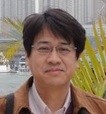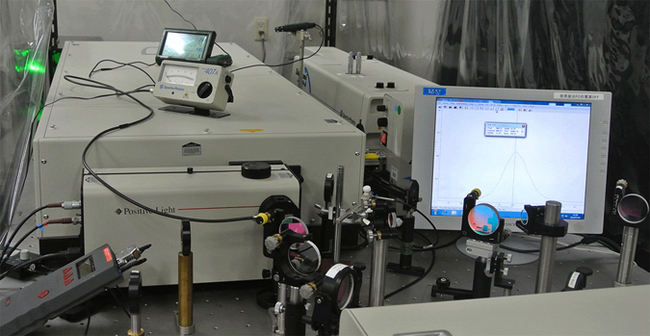Graduate School of Science and Engineering Applied Chemistry
- Course Outline
- Electrochemical Laboratory
- Laboratory of Physical Chemistry
- Polymer Chemistry Laboratory
- Laboratory of Inorganic Synthetic Chemistry
- Functional Organic Chemistry Laboratory
- Laboratory of Catalysis and Material Design
- Laboratory of Biofunctional Chemistry
- Powder Technology Laboratory
- Transport Phenomena Laboratory
- Biochemical Engineering Laboratory
- Separation and Detection Chemistry Laboratory (Analytical Chemistry Laboratory)
- Molecular Chemical Engineering
- Material System Laboratory
- Biosensing Laboratory
Laboratory of Physical Chemistry
Website of the Laboratory 【In Japanese】Exploring reactions and dynamics by spectroscopies and developing new functionality of new generation liquids
Staff

KIMURA Yoshifumi
[Professor]
| Acceptable course | |
|---|---|
| Master's degree course | ✓ |
| Doctoral degree course | ✓ |
Telephone : +81-774-65-6561
yokimura@mail.doshisha.ac.jp
Office : SC-221
Database of Researchers

ENDO Takatsugu
[Professor]
| Acceptable course | |
|---|---|
| Master's degree course | |
| Doctoral degree course | |
Telephone : +81-774-65-6562
taendo@mail.doshisha.ac.jp
Office : SC-222
Database of Researchers
Research Topics
- Ultrafast proton transfer dynamics in ionic liquids studied by time-resolved fluorescence spectroscopy
- Molecular dynamics in ionic liquids studied by transient grating spectroscopy and NMR
- Molecular interaction in supercritical fluids studied by Raman spectroscopy
- Conductivity and viscosity of solution of ionic liquids
- Chemisorption of carbon dioxide by ionic liquids
- Developing new chemical reactions using ionic liquids
- Molecular dynamics simulation of ionic liquids and supercritical fluids
Research Contents
Science of Designer Fluid
Most chemical syntheses are performed in solution phase. Solute Molecules dissolved in solution are continuously affected by the solvent molecules surrounding the solutes. The changes of the solvent species, temperature, and pressure cause the changes of the solute-solvent interaction, which results in the changes of the electronic structure and dynamics of the solute molecules in various time scales. These variations induce the selectivity of the chemical reactions. In reverse, we can control the chemical reaction by the regulation of solvent. From this point of view, fluids such as supercritical fluids and ionic liquids are attracting materials which open new science of chemical reaction. These fluids are called designer fluids in the sense that their properties can be tuned for the purpose of the application, and they are widely studied in various fields like material science, environmental chemistry, electric chemistry, and so on. In our laboratory, by applying the laser spectroscopy, NMR, and electric conductivity under various thermodynamic conditions such as high pressure and high temperature, the properties of designer fluids, their applications to chemical reactions, and synthesis of new materials using designer fluids are under investigation.
What is ionic liquid?
Ordinal salt (such as NaCl) which is composed of cation (Na+) and anion (Cl-) is in a solid state under ambient
condition due to the strong Coulomb interaction between ions. In order to liquidize the salt we have to heat the
salt to the very high temperature (ca. 1081 K for NaCl). On the other hand, very recently, liquid salts at ambient
temperature have been produced by the combination of organic cations and inorganic anions. These liquid salts are
called ionic liquids (ILs), and they are in liquids state although they are composed of ions. They are quite new
materials which did not exist before, and provide us a new field of science.
Typical properties of ILs are (1)electric conductivity, (2)very low vapor pressure., (3) inflammable, which are not
common to conventional organic solvents. ILs can dissolve various organic and inorganic materials and by utilizing
the properties (2) and (3) ILs are paid attention to as green solvent. Further the property (1) makes ILs the basic
materials in battery and condenser, and the property (2) makes ILs the material available under vacuum. Recently ILs
which dissolve proteins keeping their activity are developed, and they are expecting new materials for biochemical
science.
What is supercritical fluid?
When gaseous carbon dioxide is compressed at 25℃, phase transition from gas to liquid can be observed under certain
pressure (6.4MPa). In such a case we can see both phases (gas and liquid) and further compression of the mixture the
amount of gas decreases and finally all component becomes a single phase (liquid). However, if gaseous carbon
dioxide is compressed at 35℃, no phase transition is observed in contrast to the case at 25℃. Above a certain
temperature all gases can be compressed continuously without causing any phase transition from the gaseous phase
(dilute fluid) to the liquid phase (dense fluid). The temperature of the border is called critical temperature, and
the end point of the separation line between gas and liquid the critical point.
Generally the fluid above the critical temperature and near its critical point is called supercritical fluid. In
supercritical fluid, slight compression of the fluid induces a dramatic change of the fluid properties such as
density, transport properties, and solubility, which is utilized for the extraction and nano-particle synthesis.
Water is also available under the supercritical condition at high temperature and high pressure. Supercritical water
can dissolve organic materials in contrast to water under ambient condition, and various kinds of reactions which
cannot be done under ambient condition can be performed in supercritical water. Decomposition of pet is a typical
example.
Approach to the objects
In our laboratory, the various physico-chemical properties of designer fluids are investigated by using various spectroscopic methods, and researches are performed on the application of designer fluids to the development of materials and new design of chemical reactions. For example,
- Studies on the elementary chemical reaction process and molecular dynamics by using various kinds of laser spectroscopy.
- Studies on the structure and molecular dynamics by NMR.
- Studies on the molecular dynamics by electric conductivity.
- Studies on the structure by Raman and IR spectroscopies.
- Syntheses of new ionic liquids as a reaction media and elucidation of the reaction mechanism.
- Syntheses of metal-nano materials by using ionic liquids and supercritical fluids
- Studies on structure and dynamics by computer simulations.
Laser experimental system of fs-time resolution

Keyword
- Supercritical fluid
- Ionic liquid
- Laser spectroscopy
- Conductivity
- Nuclear spin resonance spectroscopy
- Molecular and reaction dynamics